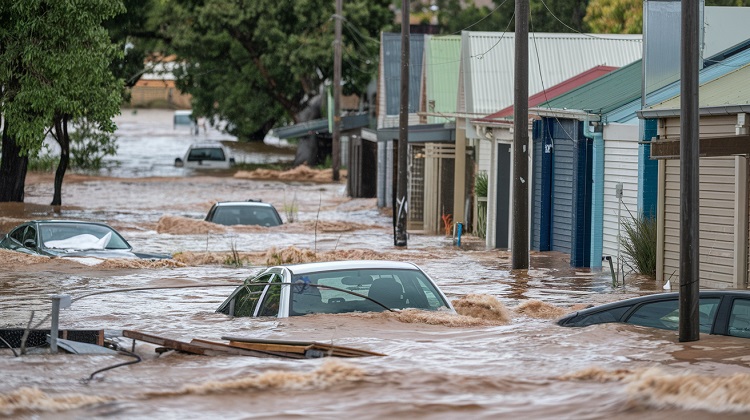A potentially severe weather system closing in on the Queensland coast could develop into a cyclone as early as Monday.
Unpredictable Weather Wreaks Havoc Across Australia
Over the past weeks, Australia has been grappling with unpredictable and chaotic weather conditions that have wreaked havoc across the nation. From intense falls and damaging winds in Northern Australia to the looming threat of a potential cyclone in Queensland, the impact of these weather events has been severe.
Moreover, Western Australia’s south-west has been grappling with severe thunderstorms, causing power outages and delays in property reconnection. As if that wasn’t enough, Tasmania, north-east New South Wales, and south-east Queensland have also experienced their fair share of flooding and storms, necessitating a heightened state of alertness.
With the wet season set to continue for the next few months, the unpredictability of weather patterns in Australia poses ongoing challenges and reinforces the need for vigilance. As we delve deeper into the various impacts and implications of this unpredictable weather, it becomes evident that Australia’s resilience is being tested.
Key Takeaways
- Intense rainfall and a monsoon trough in Northern Australia have caused damaging winds, flash flooding, and potential cyclone activity.
- The Queensland coast, particularly from Cooktown to Mackay, faces a significant risk of impact from a developing tropical cyclone.
- The unpredictability of weather patterns has been observed this season, with Queensland experiencing record flooding and a wet season expected to continue for a couple of months.
- Western Australia has been affected by severe thunderstorms, leading to power outages and a need for property reconnection. In other regions, Tasmania, north-east NSW, and parts of Queensland have also experienced flooding and storms.
Intense Weather Conditions in Northern Australia
Intense weather conditions continue to wreak havoc in Northern Australia, causing widespread damage and posing potential threats to both life and property. The monsoon trough is moving slowly over the Northern Territory, bringing heavy rainfall across the region. Darwin is expected to experience damaging winds on Thursday, while Tennant Creek faces the risk of life-threatening flash flooding.
Meanwhile, Queensland is preparing for another potential cyclone, with a tropical low building in the Coral Sea. This weather system is likely to become a tropical cyclone and could have a significant impact on the Queensland coast next week, particularly affecting coastal areas from Cooktown to Mackay. The Bureau of Meteorology has warned of severe impacts, highlighting the unpredictable nature of weather patterns this season.
Potential Impact on Queensland Coast
The potential impact on the Queensland coast looms as a tropical low in the Coral Sea intensifies, with the weather system likely to become a tropical cyclone. The Bureau of Meteorology has warned of a significant risk of impact on the Queensland coast next week, particularly in coastal areas from Cooktown to Mackay.
The severity of the impact is expected to be severe, with potential for damaging winds and heavy rainfall leading to life-threatening flash flooding. The unpredictability of weather patterns this season has heightened concerns, as the state has already experienced record flooding and a massive clean-up effort in the far north.
With the wet season expected to continue for a couple of months, it is crucial for residents and authorities to remain vigilant and prepared for the potential impact of this approaching weather system.
Unpredictability of Weather in Australia
As the potential impact on the Queensland coast looms due to the intensifying tropical low in the Coral Sea, the unpredictability of weather patterns in Australia becomes increasingly apparent.
Queensland has been experiencing intense falls and record flooding, with a massive clean-up effort underway in the far north. The wet season is expected to continue for a couple more months, with the wettest months typically occurring in February and March. This season, weather patterns have shown a significant level of unpredictability.
In addition to Queensland, other regions in Australia have also been affected by unpredictable weather, such as severe thunderstorms in Western Australia causing power outages and flooding in Tasmania and New South Wales.
The unpredictability of weather poses challenges for residents, emergency services, and infrastructure planning across the country.
Severe Thunderstorms in Western Australia
Severe thunderstorms in Western Australia have caused power outages and property damage in the south-west region. The first round of thunderstorms resulted in widespread power outages, leaving some properties without electricity for up to a week. The affected areas are now facing a significant recovery effort to restore power and repair damaged property.
The severe weather conditions have been attributed to the dry conditions prevailing in inland areas.
Meanwhile, in other parts of the country, showers and thunderstorms continue to persist in north-east New South Wales and south-east Queensland. The unpredictability of the weather patterns this season has been evident, with thunderstorms tracking further north than initially forecasted, leading to flash flooding and river rises in north-east New South Wales. The State Emergency Service has issued warnings urging people to stay alert for further flooding.
Flooding and Storms in Tasmania
In Tasmania, heavy rainfall and storms have caused significant flooding and disruptions in the region. The low-pressure system has brought heavier falls than expected, resulting in flash flooding and river rises in northeastern parts of New South Wales as well.
The State Emergency Service (SES) has urged people to stay alert for further flooding and has forecasted rainfall of up to 70 millimeters in some parts of New South Wales. The thunderstorms have also tracked further north than originally forecasted, adding to the unpredictability of the weather patterns this season.
As a result, residents and authorities in Tasmania are facing challenges in managing the flooding and ensuring the safety of the affected areas. The situation highlights the need for preparedness and resilience in the face of unpredictable weather events.
Thunderstorms Track Further North Than Expected
The unpredictability of weather patterns in Tasmania has been further highlighted by thunderstorms that have tracked further north than originally forecasted. This unexpected deviation in the storms’ path has caught many residents off guard and has resulted in additional challenges for those already dealing with the aftermath of flooding in the region.
The thunderstorms, accompanied by heavy rainfall, have caused flash flooding and river rises in the north-eastern parts of New South Wales. The State Emergency Service (SES) has issued warnings for people to stay alert for further flooding and has forecasted rainfall of up to 70 millimeters in some areas.
This further emphasizes the need for residents to remain vigilant and prepared for the unpredictable weather conditions that continue to wreak havoc across Australia.
Flash Flooding and River Rises in North-East NSW
Flash flooding and river rises in the north-eastern parts of New South Wales have caused significant challenges for residents already grappling with the aftermath of flooding in the region. The heavy rainfall and rising river levels have resulted in further inundation of homes and infrastructure, exacerbating the existing damage caused by the recent floods.
The State Emergency Service (SES) has issued warnings and urged residents to stay alert for further flooding as rainfall of up to 70 millimeters is forecasted in some parts of NSW. The SES is working tirelessly to provide assistance and support to affected communities, conducting rescues and providing essential supplies.
The unpredictable weather patterns this season have posed difficulties for residents and emergency services, highlighting the need for ongoing preparedness and resilience in the face of such challenges.
Stay Alert for Further Flooding in Australia
Residents and emergency services in Australia are urged to maintain vigilance as the risk of further flooding persists amidst the unpredictable weather patterns experienced across the country.
The recent heavy rainfall and severe thunderstorms have already caused flash flooding and river rises in several regions, including north-east NSW. The State Emergency Service (SES) has advised people to stay alert for further flooding, as rainfall of up to 70 millimeters is forecasted in some parts of NSW.
The unpredictable nature of the weather this season has made it difficult to predict the exact areas that may be affected. Therefore, it is crucial for residents and emergency services to stay prepared and take necessary precautions to ensure the safety of individuals and minimize damage caused by flooding.
Albion News is a great place to find informative, up-to-date news articles. We provide a wide range of unique articles that offer an interesting perspective on current events from around the world and from various different sources. You can easily search for the topics that matter most to you and explore in-depth pieces that provide insight into the issues and important debates occurring today. Albion News helps you stay informed with carefully researched and credible stories!







